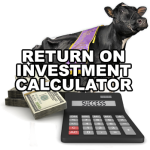With the introduction of Genomics to the dairy industry the marketplace has greatly changed. And while this may be true, the silent factor that many don’t consider is in vitro fertilization (IVF). While Genomics is changing what the marketplace is looking for (Read more – An Insider’s Guide to What Sells at the Big Dairy Cattle Auctions), IVF has changed who in the marketplace are actually able to make money. Causing boom for a select few but a bust for many others.
Through IVF we can get way more progeny/genetics from the top cattle. This causes an abundance of supply in the marketplace. With greater supply at the top end but not equally greater demand, the prices for all sectors in the marketplace are forced downward.
In the past, when embryo exporters were looking to fill orders, they may be held to a threshold of +2500 LPI or +1,900 TPI. Now since there is so much more supply at the top end, their threshold has risen to +3,200 LPI or +2,500 TPI. Have a look at our recent analysis of the public auction of live cattle. You will see that the very top cattle draw the high prices and then the prices drop significantly (Read more – Who Killed the Market for Good Dairy Cattle?).
No big deal you say?
Well actually it is. When the threshold gets that high you are talking about less than the top 0.5% of the breed. This means that those at the very top who have that base can supply this market. All those others who used to do embryo transfer work, partly for genetic advancement of their herd and partly for profit, now have no market for their embryos. They are having to rethink whether they can even afford to do the embryo work in their herd, without the added revenue from embryo sales, it’s hard to justify the expense.
As pointed out in a recent Holstein International article, Genomics has certainly created a gold rush, but not for the breeders, but rather for the embryo transfer companies. During the gold rush, a few diggers struck it rich, while many others strike out (Just like those in the genomic market). The one sure way to have made money during the gold rush was to be a supplier of equipment, food, or clothing to the diggers. As Holstein International points out, the service provider in the Genomic gold rush is the embryo transfer industry and its range of advanced technologies.
These are Big Changes. Are they Good or Bad?
In our interview earlier this year with Mark Allen PhD, Director of Marketing and Genomics for Trans Ova (Read more – Fast Track Genetics: More Results in Less Time), a company that has performed ovum pickup aspirations on 8,668 in the first 8 months of this year alone, we asked Mark if these changes were good or bad for the industry. The following was his response:
“It is human nature, when presented with the latest greatest technology to look for the downside. You ask yourself, “What is the worst case scenario?” Some breeders may be concerned that the market is being flooded, leaving no room for the middle market cattle. To that comment, Dr. Allan gives this well-considered response, “Many technology improvements have led to dramatic increases in genetic improvement. One of the early changes that led to a giant leap in genetic gain was implementation of artificial insemination (AI) in the dairy industry. This technology is widely accepted today and used by producers large and small. Historically, each time a new technology has been introduced to the reproductive technology continuum, there has been some resistance and trepidation about how it will affect breeders. Changes in the marketplace may require that producers have to make a change in how they utilize their animals coupled with available technology. This may mean changing the current paradigm that exists for some segments of the industry.”
Are you ready to change?
One person who has seen this coming is the forward thinking David Dyment. While David is very well known for his work with Glen Drummond and Dymentholm Genetics, (Read more – Marketing Lessons from Glen Drummond Aero Flower) as well as being the Associate Judge at the 2012 World Dairy Expo (Read more – World Dairy Expo 2012 Holstein Show – A Battle for the Ages). David saw where the market was heading and in 2009 formed a partnership with Mike and Julie Ducket and established Genetic Futures. A 300-acre farm in Wisconsin that has became a satellite base Trans Ova, housing top donors and recipient services are provided.
I think it’s significant when a person like David Dyment, who has worked with high-end show cattle, high-end index animals and, as well, has run the roads filling commercial orders, is now focusing on being a supplier of the service and not the product. The market has changed drastically. Breeders are only left with three options:
- You can either purchase and be the supplier of those top genetics, which is extremely costly to buy and almost equally as costly to produce;
- You can do traditional embryo for personal use only and avoid the high cost of IVF;
- You can go broke trying to compete in a market that is just too saturated.
The Bullvine Bottom Line
As long as breeders of the top genomic index animals continue to over supply the marketplace through technologies like IVF, there will only be a market for the very select few. So next time you decide to do a flush, make sure you are doing it for the right reasons. If it’s to advance the genetics in your own herd? Great! If it’s to get rich from embryo sales? Maybe you should think again.
Not sure how much to spend on that great 2 year old or heifer?
Want to make sure you are investing your money wisely?
Download our Dairy Cow Investment Calculator.


















Leave a Reply
You must be logged in to post a comment.